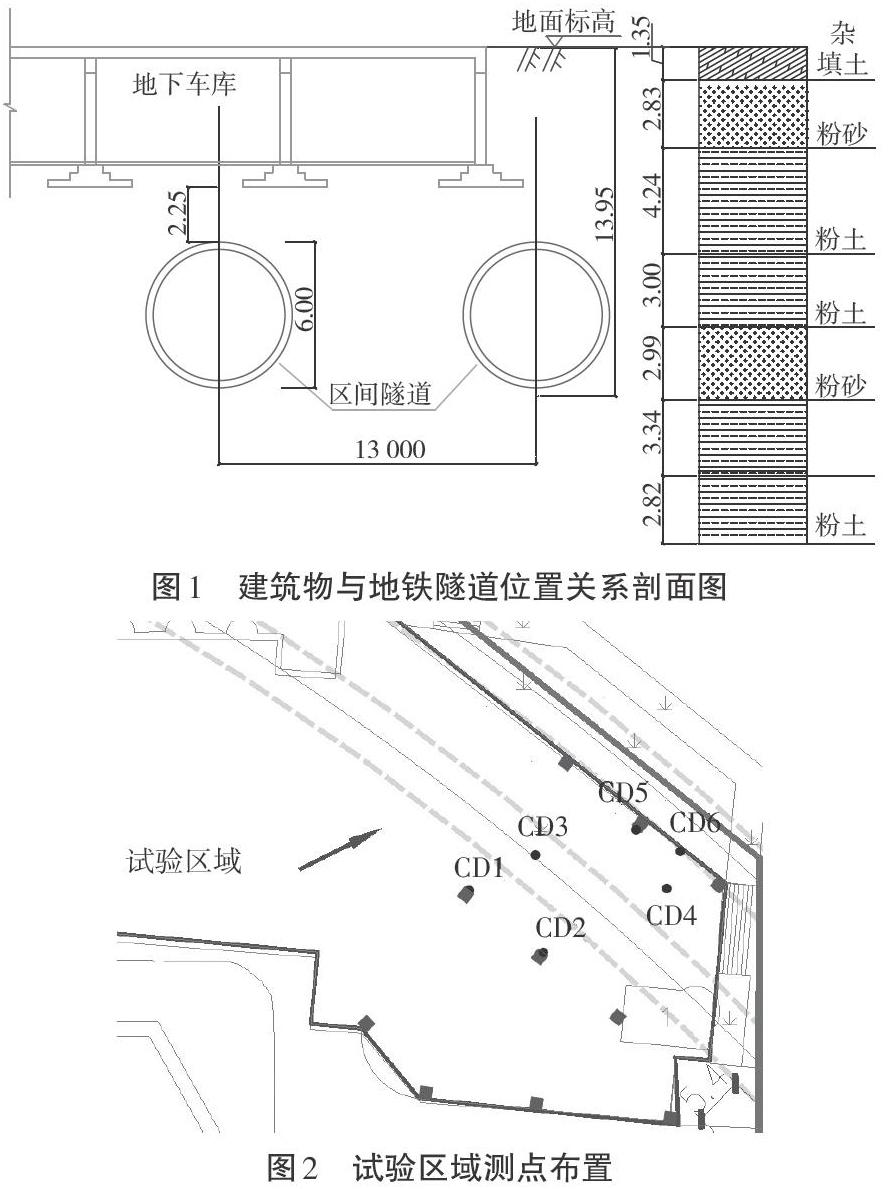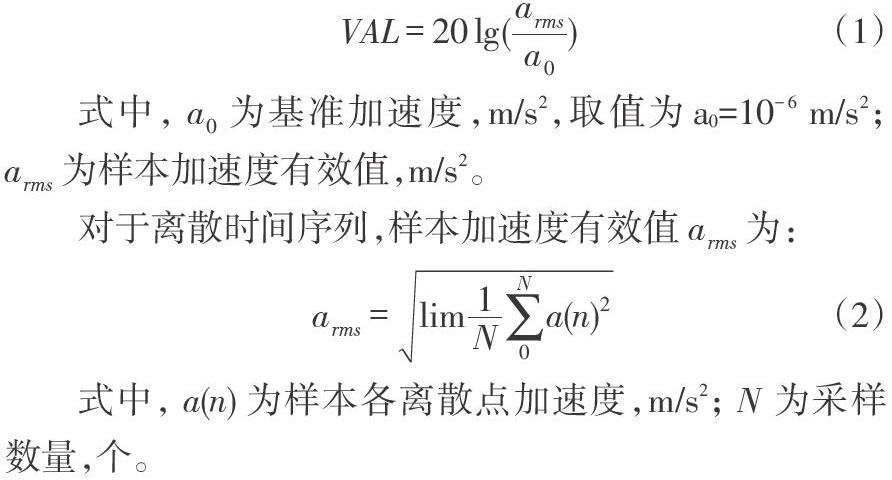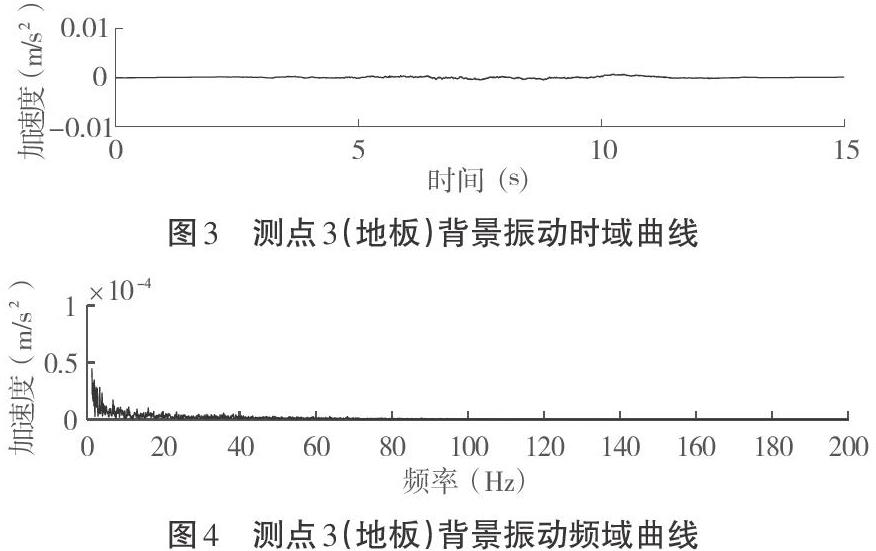地铁运行引起上方建筑振动的现场实测与规律分析
张亚彬 秦学波 韩旭



摘 要:为评价地铁运行对上方建筑的振动影响,本文以郑州地铁1号线上方泰隆广场地下停车场为研究对象,提取地铁运行下的建筑多部位的动力信号,在预处理后统计振动加速度峰值、振级及振动主频。结果表明,地铁经过建筑下方时,建筑振动量增大;建筑各部位振动三向特征不同,地板竖向振动显著,立柱水平振动强度较大,墙体垂直于墙面方向的振动最为显著;该段区间内列车运行速度较小,所引起的建筑振动未超过限值。
关键词:地铁振动;现场实测;振动加速度;振级;振动主频
中图分类号:X827文献标识码:A文章编号:1003-5168(2020)29-0119-03
Abstract: In order to evaluate the impact of subway operation on the vibration of the building above, this paper took the underground parking lot of Tailong Plaza above Zhengzhou Metro Line 1 as the research object, and extracted the dynamic signals of multiple parts of the building under subway operation, and counted the vibration acceleration peak, vibration level and main frequency of vibration after preprocessing. The results show that when the subway passes under the building, the vibration of the building increases; the three-dimensional characteristics of vibration in each part of the building are different, the vertical vibration of the floor is significant, the horizontal vibration of the column is strong, and the vibration of the wall perpendicular to the wall is the most significant; the train running speed in this section is relatively low, and the building vibration caused by it does not exceed the limit.
Keywords: subway vibration;field measurement;vibration acceleration;vibration level;vibration frequency
受列车动力荷载及铁轨不平顺等原因影响,地铁列车运行期间易出現较大振动,通过铁轨—隧道—地层的方式传播至上覆建筑。地铁运行造成的振动可能影响居民正常生活,造成低矮建筑物结构损伤,影响精密仪器所、博物馆等特殊场所的正常运营[1]。
国内外学者针对地铁环境振动问题进行了大量现场监测试验[2-4],然而对于地下建筑结构的振动特征监测尚缺。本文对比地铁列车通过前后引起上方建筑振动的加速度数据,分析了地铁运行引起建筑振动的影响。
1 现场振动实测及规律分析
1.1 测点布置与试验仪器
动力信号的采集试验场所位于郑州地铁1号线碧沙岗站~绿城广场站区间。试验地点为区间上方的泰隆广场地下停车场。该建筑为单层钢筋混凝土结构,基础埋深为5.7 m,与地铁隧道竖向距离仅有2.6 m,如图1所示。
本次试验设置在某工作日11:00—11:30交通繁忙时期,且试验期间地下室暂停使用,外界因素对采样数据的影响较小。采用INV9832三向加速度传感器,结合INV3062数据采集仪实现各测点动力加速度的采集,并利用DASP软件实时分析数据。振动传感器分别布置于立柱、地板、墙体等部位,共有6个测点(CD1~CD6),且立柱侧面与墙面近似与隧道方向平行。加速度传感器测试方向定义为:设定x方向为隧道横断面水平方向,y方向为沿隧道纵向,z方向为铅垂方向。采样频率设置为512 Hz。试验区域测点布置如图2所示。
1.2 振动评价标准
针对交通荷载产生的复合振动信号,通常以加速度、速度、位移为基础值计算评价量,并判别振动强度是否超限。本文选取《城市区域环境振动标准》(GB 10070—1988)及《城市轨道交通引起建筑物振动与二次辐射噪声限值及其测量方法标准》(JGJ/T 170—2009)中的振动加速度级[VAL](Hz)作为振动评价指标。
式中,[a0]为基准加速度,m/s2,取值为a0=10-6 m/s2;[arms]为样本加速度有效值,m/s2。
对于离散时间序列,样本加速度有效值[arms]为:
式中,[a(n)]为样本各离散点加速度,m/s2;[N]为采样数量,个。
根据本文测试场地使用性质,按商业中心区规定,其昼间振级限值为75 dB。
振动信号在传递与输出中会混入干扰成分,在分析前需要做预处理,以提高数据的真实性和稳定性。预处理主要涉及数据奇异点剔除、去直流、平滑处理、消除趋势项等工作[5-6]。
2 结果与分析
现场试验针对无列车经过环境下和列车经过环境下的建筑振动分别进行监测。篇幅所限,仅展示地板部位测点3背景振动时域及频域曲线,如图3、图4所示。

